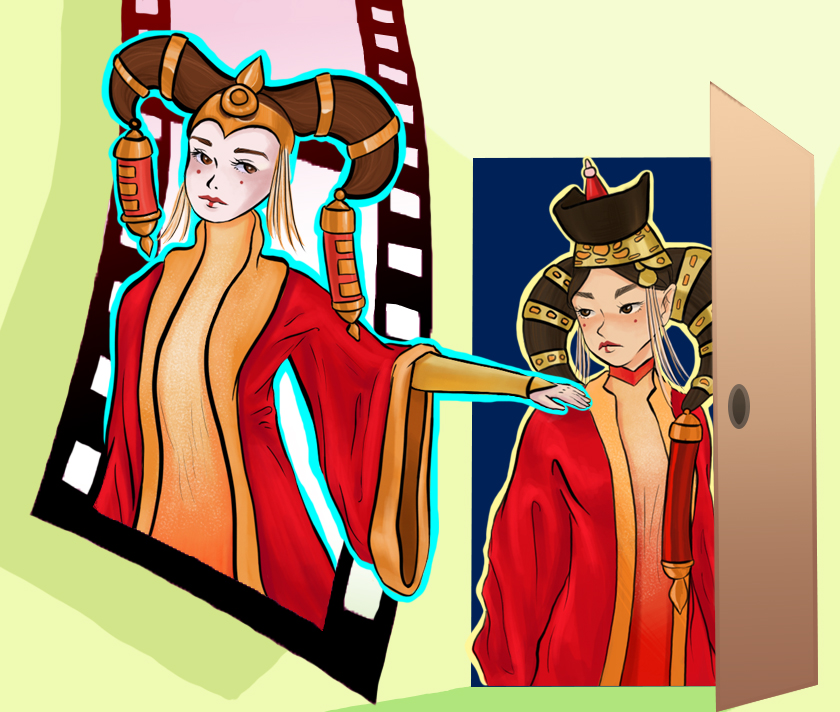The Westernized “Other”: Cultural appropriation in the media
Graphic illustration by Christy Yu
In many productions by Western creators, cultures are commonly copied without appreciation or respect for the culture.
November 4, 2020
Worldbuilding in the lore of movies, films and shows is key to the creation of many fictional favorites, such as “Star Wars”, “Avatar” and “Game of Thrones”. As Western media begins to include more fictitious cultures, however, they often portray real cultures as alien or exotic, which can be harmful. By using real cultures in media, creators often portray them inaccurately or lacking the most fundamental part of worldbuilding when creating new cultures: creativity.
In many Western films and movies, fictitious cultures often borrow heavily from other real cultures. Because many Eastern cultures are vastly different from Western cultures, they are often considered exotic enough to pass off as fictional and alien. For example, in the world of “Star Wars,” the culture of the alien planet Naboo is largely influenced by Mongolian clothing and customs. Instead of studying and referencing several cultures to develop a new fictional one, the writers directly copied from Mongolian clothing and language. Queen Padme Amidala’s crown is nearly identical to traditional Mongolian headdresses, which women of status wear. Much of Padme’s clothing was also directly influenced by Japanese geishas and Mongolian royalty dresses.
The alien cultures that mirror real ones reveal a harmful message: real, non-Western are alien or exotic. Cultures should not be viewed as alien just because they are vastly different; Western cultures should not be deemed as the main culture with everything else being deemed as other.
“Any clearly minority-modeled cultures in which the people are barbaric, uncivilized or just unimportant can be problematic, especially when the Western characters are the civilized protagonists,” senior Livia Zhu said.
Portraying these cultures as inferior and unimportant is one way the practice can be harmful. It sends the message that these cultures are not worth understanding or treating with respect; instead, its aesthetics serve the purpose to support the Western character or people.
The diverse African and Asian ethnic groups and regions in “Game of Thrones” are also classified as exotic, with most main storyline characters having never set foot there. While YiTi, the counterpart to Eastern Asian cultures, is mentioned as the most advanced civilization in their world, almost no characters from there are ever mentioned.
“The only three relevant characters mentioned in depth in the story — Khal Drogo, Greyworm and Missandei — are also primarily used to support one of the main characters, Daenerys’ character growth, and often lack greater character development,” senior Flora Huang said.
Additionally, relying too heavily on one culture is not creative, and a rather lazy way to create a fictional culture for lore. It is normal to reference several cultures when creating a new one for worldbuilding, but relying too heavily on one is both unoriginal and unimpressive.
“Creators take from what they know,” Zhu said. “However, I think it’s most important to take the concepts and reapply that instead of the aesthetic. For example, the ancient Chinese had long sleeves because it was a display of wealth to be able to afford that much silk. You can take this idea and think about how you can incorporate the concept into your fictitious culture instead of simply copying over wide sleeves.”
The movie “Avatar” also heavily borrows from Indigenous culture; it is very much like other movies about Indigenous people such as “Pocahontas”, only the main difference is that the characters are blue. In “Avatar”, the music and singing of the Na’vi’s, the Indigenous counterpart, are based on the Western stereotype of non-Western music. Although by Westernizing an existing culture creators are making a new one, it is still lazily done, as it does not add extra value or depth into the culture. Once again, this perpetuates a false image of non-Western cultures in the Western creators’ view, providing distorted and possibly even harmful perspectives without thoroughly researching Indigenous culture and appreciating them for what they are.
In fact, in another “Star Wars” culture, the fictional language Ewok copied words from Tagalog and Kalmyk Oirate, the language of the Mongolian group Kalmyk. However, unlike Ewok, the Na’vi language is the one unique aspect of its culture, and deepens our understanding of the Na’vi as a whole. Instead of mixing words from several languages and replacing them with English words, the Na’vi language is completely made up and has its own grammatical structure designed by Paul Frommer, a professor and linguist at the University of Southern California. It even includes its own unique accent and sounds when a native Na’vi is speaking in English. Overall, the Na’vi language is an interesting example of a fictitious language that actually uses creativity in world building, rather than simply copying from another culture.
It is not to say that creators can not portray a real foreign culture in their stories either. Respect for a culture is an important aspect of portrayal. For instance, Disney & Pixar’s “Coco” is a positive example of accurately portraying real cultures. Accuracy achieved by thorough research shows care and respect for the culture producers are portraying.
“Positive portrayal of other cultures comes through genuine appreciation and research of them and not just picking and choosing the most appealing characteristic to Western audiences, ” Zhu said.
Perpetuating narrow minded viewpoints by taking advantage of a culture’s exoticness without creating depth shows lack of appreciation for a culture’s significance. Instead, creators should respect cultures by either portraying them accurately with careful research or by creating an entirely fictitious culture that borrows elements and not merely the aesthetics of real cultures.





































































M.S • Feb 8, 2022 at 12:57 pm
I don’t disagree with all your points or anything but complaining about the Ewok language is coming like 50 years too late. Even Avatar isn’t really current media. It’s almost 14 years old now. I’m Asian myself and I totally cringed when Phantom Menace came out since it’s just a giant pile of racial stereotypes but honestly I feel like a lot of improvement has happened since then. Cherry picking from over 50 years of cinema history without context for time fails to show a lot of the honest work story writers have done. It’s still a problem and there is more work to be done. You have a valid argument here but your missing an important part, in my opinion. Thanks for sharing!
Hunter • Nov 6, 2021 at 11:15 am
I agree that using other cultures from your own in media/fiction is awesome AND those cultures should be shown as awesome, not just “less than.” I think some of the anti-examples did better than they get credit for. The Game of Thrones books are actually and very publicly the historic War of the Roses, plus magic. It was an epic war that happened throughout Europe, that included Mongolian raiders, in Europe (at the time when Mongolia dominated much of the world). So of course Game of Thrones will give more “screen time” to European-inspired elements — because it’s from European history.
Shuppet • Nov 4, 2021 at 8:21 am
It’s ironic that the writer is of Asian decent, considering how prejudiced they tend to be towards other cultures themselves. Japanese vs Chinese immigrants for example, or Koreans there’s some deep seeded hate vs other cultures and the west isn’t the only one doing it, play the whole game not just the piece that makes you comfortable.
M. s. • Feb 8, 2022 at 12:47 pm
So your argument is, we’re not racist, your racist. You didn’t exactly prove her wrong.
Cheetah Von tiebolt • Jul 13, 2021 at 8:51 am
I am half mongolian on the mongol enthusistems mist people lije Queen amidala look i believe in freedom of expression if you fo not lije sonething do not listen to or watch it they are sterotypes about evertone